The Playing And Notation of The Left Hand - 4
|
| Click the pictures to view the videos. |
|
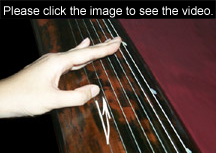 |
Notation:
Name: Jìn fù 進復 (advancing and returning)
Explanation: When a finger of the left hand presses down a string, and after the right hand has pulled the string, the left hand glides up to the right to a certain point indicated or to one pitch higher, then glides back to where it started.
|
|
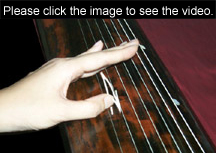 |
Notation:
Name: Tuì fù 退復 (backward and returning)
Explanation: Opposite of Jìn fù. When a finger of the left hand presses down a string, and after the right hand has pulled the string, the left hand glides down to the left to a certain point indicated or one pitch lower, then glides back to where it started. |
|
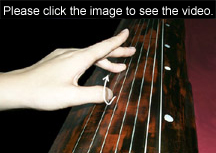 |
Notation:
Name:Qiā qǐ 掐起
Explanation: This technique is particularly used for the thumb of the left hand. After the thumb presses down a string (on the 8th Hui for example), the ring finger (or middle finger) presses down the same string at the next Hui (the 9th). Instead of using the right hand to pull the string, the thumb of the left hand pulls up the sting. Using the edge of the thumbnail to pull the sting up, at the same time the ring finger (or the middle finger) still presses down steadily. |
|
 |
Notation:
Name: Zhua Qĭ 抓起
Explanation: This technique is particularly used for the thumb of the left hand. After the thumb presses down a string, it lightly pulls up the string to create a Săn Yin. |
|
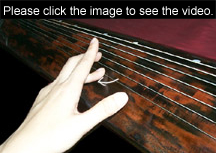 |
Notation:
Name: Dài Qǐ 帶起
Explanation: This technique is particularly used for the ring finger of the left
hand. After the left ring finger presses down a string, it plucks the string to create a Sǎn Yin. However, some ancient qin tabletures used "Dài qǐ" not just for the ring finger but for the thumb (as Zhua Qǐ) and middle finger as well.
|
|
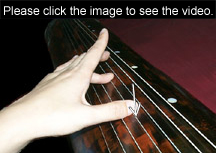 |
Notation:
Name: Yǎn 罨 (to cover)
Explanation: This technique is mostly executed with the left hand thumb, that the thumb taps a string to produce a low, dull sound after the left ring finger pressed down the string. For example, when the left ring finger presses down the 3rd string on the 10th Hui, the left thumb taps the same string on the 9th Hui (while the left ring still presses down).
and after tapping the string, the left thumb stays there steadily and does not move away.
|
|
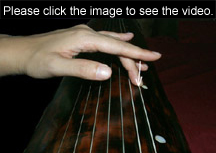 |
Notation:
Name: Xū Yǎn 虛罨
Explanation: This technique is mostly executed with the middle or ring finger and sometimes the thumb. Same technique as Yǎn but without pressing down any string before doing Yǎn.
|
|
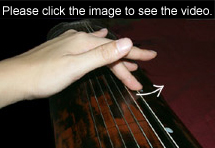 |
Notation:
Name: Tue Chu (pushing outward) 推出
Explanation: This technique is particularly used on the 1st string for the middle finger of the left hand. After the middle finger presses a sting down, it makes the 1st string sound by pushing it outward. |
|
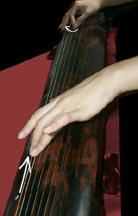 |
Notation:
Name: Yīng Hé 應合 (respond and unite)
Explanation: The left middle or ring finger presses down a string, and the right hand plucks it, the left hand stays on the same string and does not move away yet. While the right hand plucks another string,
the left hand moves either up or down to the position where it has the same sound as the string that the right hand had played. Eventually making both strings sound together (one is a solid sound, the other is a soft sound).
|
|
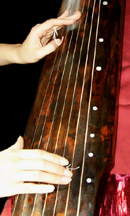 |
Notation:
Name: Tóng Shēng (sounds together) 同聲, also called Dài Hé 帶合
Explanation: This technique is creating a kind of chord. The left hand plucks one string (can be the middle finger Tuīchū, or the ring finger Dàiqǐ or the thumb Zhuāqǐ), at the same time, the right hand plucks another string to make both strings sound together. |
|